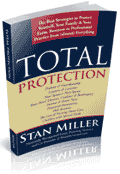IRA Protection Planning
IRA accounts and other tax qualified retirement accounts require special handling.
In many states, including Arkansas, IRA accounts are not protected from creditor claims. This makes asset protection of IRA accounts problematic. The account holder received an income tax deduction for each contribution to the account. Because these accounts obtain this tax benefit, they are also subject to certain rules that are unique to this kind of asset. For example, the ownership of this asset cannot be changed without the transfer of ownership being treated as the removal of the assets from the account and the complete recognition of the transfer as an income taxable event. For this reason, it is rare that a client chooses to change the ownership of the account. The planning associated with IRA accounts generally relates to the naming of beneficiaries of the account. Account holders generally have two objectives:
- Providing divorce and lawsuit protection to the beneficiary
- Maximizing the opportunity for “stretch-out” of distributions from the account to the beneficiary
There are three options available to the account holder:
- Name an individual
- Name a testamentary trust created in a will or living trust
- Name a Stand Alone IRA Trust as beneficiary
As Little Rock based tax lawyers, we understand the need for IRA protection.
We understand the most effective strategies for IRA planning. We know that our clients have a deep desire to protect their IRA account, 401k or other tax qualified account from creditors and from bankruptcy. Advising clients on how to best provide this protection is part of the service we provide.
The U.S. Supreme Court Says IRA’s Are Not Protected
In June of 2014, the U.S. Supreme Court made it clear that for federal bankruptcy purposes, inherited IRAs are not protected from creditors’ claims. The Supreme Court’s opinion in Clark, et ux v. Rameker, 573 U.S. (2014) has deep implications for anyone who looks to leave a significant IRA balance to heirs. The Court held unanimously that retirement funds inherited by a beneficiary are not considered to be “retirement funds” protected by federal bankruptcy exemptions. As a result, the IRA account you leave your heirs is at risk of being lost to your heirs’ creditor claims unless you take steps to protect it.
Naming A Living Trust As The IRA Beneficiary
In order to provide all of the benefits most clients want and avoid mandatory liquidation of the inherited IRA over a period as short as five years, a living trust agreement must be carefully crafted as a “See-Through Trust.” A “See Through Trust” insures that the required minimum distributions can either remain inside the trust (an “accumulation trust”), or be paid out over the oldest trust beneficiary’s life expectancy (a “conduit trust”). We generally draft our living trusts to include the “conduit trust” features. This allows the assets in the IRA to be protected, but the “conduit” feature requires that the required minimum annual distribution be paid out to the trust beneficiary regardless. This could be problematic if the beneficiary has a drug or alcohol issue or has an outstanding judgment. This problem is solved with an “accumulation” trust. However, it is virtually impossible to draft a revocable living trust in a way that can provide the “accumulation trust” feature because the IRS requirements to qualify the trust for this feature conflict with other provisions most clients want in their living trust.
The Standalone Retirement Trust Is Usually The Best Solution
In many cases, the best option to protect an inherited IRA is to create a Standalone Retirement Trust for the benefit of all of the intended IRA beneficiaries.
Benefits of a Standalone Retirement Trust
If properly drafted, this type of trust offers the following advantages:
- Protects the inherited IRA from each beneficiary’s creditors
- Insures that the inherited IRA remains in the family bloodline and out of the hands of a beneficiary’s spouse
- Allows for experienced investment management and oversight of the IRA assets by a professional trustee
- Prevents the beneficiary from wasting the inherited IRA
- Enables proper planning for a special needs beneficiary
- Permits minor beneficiaries, such as grandchildren, to be immediate beneficiaries of the inherited IRA without the need for a court-supervised guardianship
- Facilitates generation-skipping transfer tax planning to insure that estate taxes are minimized or even eliminated at each generation
The Tax Implications
There are some tax implications to making a trust the beneficiary of an IRA account. Trust tax brackets are compressed and max out at 39.6% (Federal) at $12,300 of income (in 2015). The comparatively high tax rate can be avoided by distributing the income to the beneficiary, however. There are also some ongoing accounting and trustee fees as well as the added complexity of administering the trust year after year. It is important that planning with a Standalone Retirement Trust be coordinated with the IRA beneficiary designation.
How its Different from Your Living Trust
A Standalone Retirement Trust that has specific provisions for administering retirement accounts that are separate and distinct from a client’s revocable living trust. Your living trust has been drafted to address the entire range of non-retirement assets. The Standalone Retirement Trust incorporates some very specific IRS requirements that allow for the accumulation of assets inside the trust. This can be critical if the beneficiary is abusing drugs or alcohol, has a judgment outstanding or is spending money unwisely. This is why we like the Standalone Retirement Trust as the preferable type of IRA trust beneficiary.
Using a Standalone Retirement Trust to Protect a Spouse
It’s important to note that provisions can be made in a Standalone Retirement Trust for a spouse. This is important for creditor protection for the spouse, but for other reasons as well. Many of our clients would like for their IRA account to be protected from their spouse’s next spouse if the spouse remarries after the account holder dies. It’s also important in a blended family or if the spouse eventually needs nursing home care and seeks to qualify for Medicaid. A layered IRA beneficiary designation which includes a Standalone Retirement Trust and disclaimer planning can offer a great deal of flexibility for clients who want to insure that their hard-saved retirement funds stay in their family’s hands and out of the hands of creditors and predators.
Some States Provide Their Own Protection—But Arkansas Can’t
In the wake of the Clark decision, a number of states – including Alaska, Arizona, Florida, Idaho, Missouri, North Carolina, Ohio and Texas – have either passed laws or had favorable court decisions that specifically protect inherited IRAs under state bankruptcy exemptions for federal bankruptcy purposes. However, Arkansas’ 1874 constitution limits the ability of the Arkansas Legislature to enact similar legislation. But if the IRA beneficiary lives in one of the states that has passed this legislation, then the beneficiary may very well be able to protect their inherited retirement funds by claiming the state exemption instead of the federal exemption. People are more mobile now and may move from state to state to find work, pursue educational goals, or be closer to elderly family members in need of assistance. However, federal bankruptcy law now requires a debtor to reside in a state for at least 730 days prior to filing a petition for bankruptcy in order to take advantage of the state’s bankruptcy exemption, so relying on a specific state’s laws requires thoughtful planning.
Are You Ready to Provide Total Protection for Your IRA Accounts?
Our mission is to provide total protection and peace of mind to our clients. And for many, their retirement account is a significant asset and sometimes the only asset with significant value. So making sure it is properly protected is something that matters to us. We are here to answer all of your questions about protecting beneficiaries of retirement accounts through Standalone Retirement Trusts, disclaimer planning, and layered beneficiary designations.
Our Connections






ILP + The Book

It is possible to protect yourself, your family and your business or professional practice from the real threats that keep you up at night. The law provides more and better solutions than ever before in history. In this book, Stan explains in clear, understandable language how these powerful solutions can be deployed to protect what you have earned and built.
Available Early Summer 2015
ILP + The Webinar

In this hour-long webinar, Stan explains how to avoid probate and protect your heirs with a revocable living trust. You will learn how to protect your loved ones what many consider to be an expensive, lengthy, and unnecessary court process. You will also learn what a living trust is and why having a living trust will protect your children, grandchildren and other heirs.
Available Now









